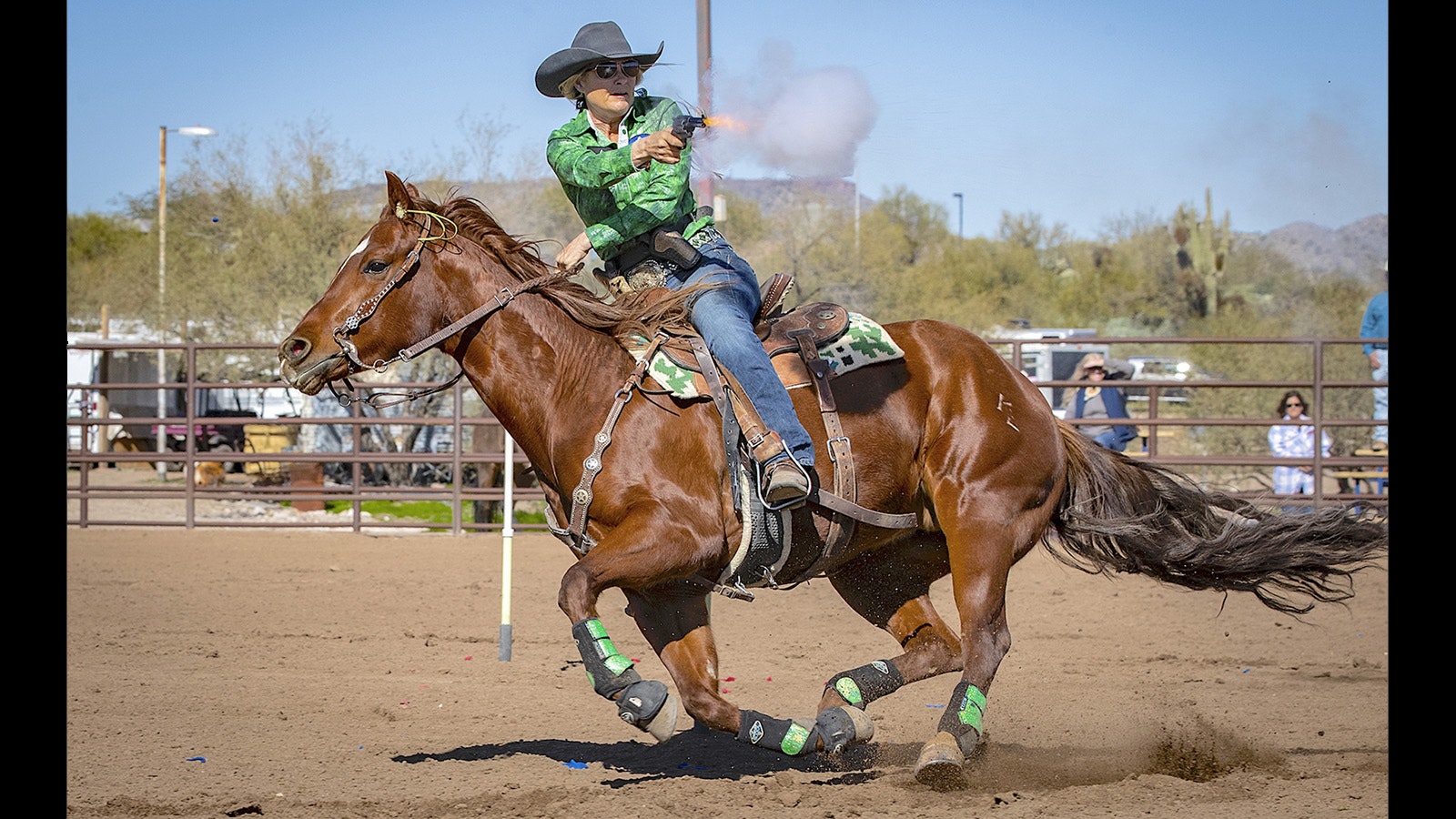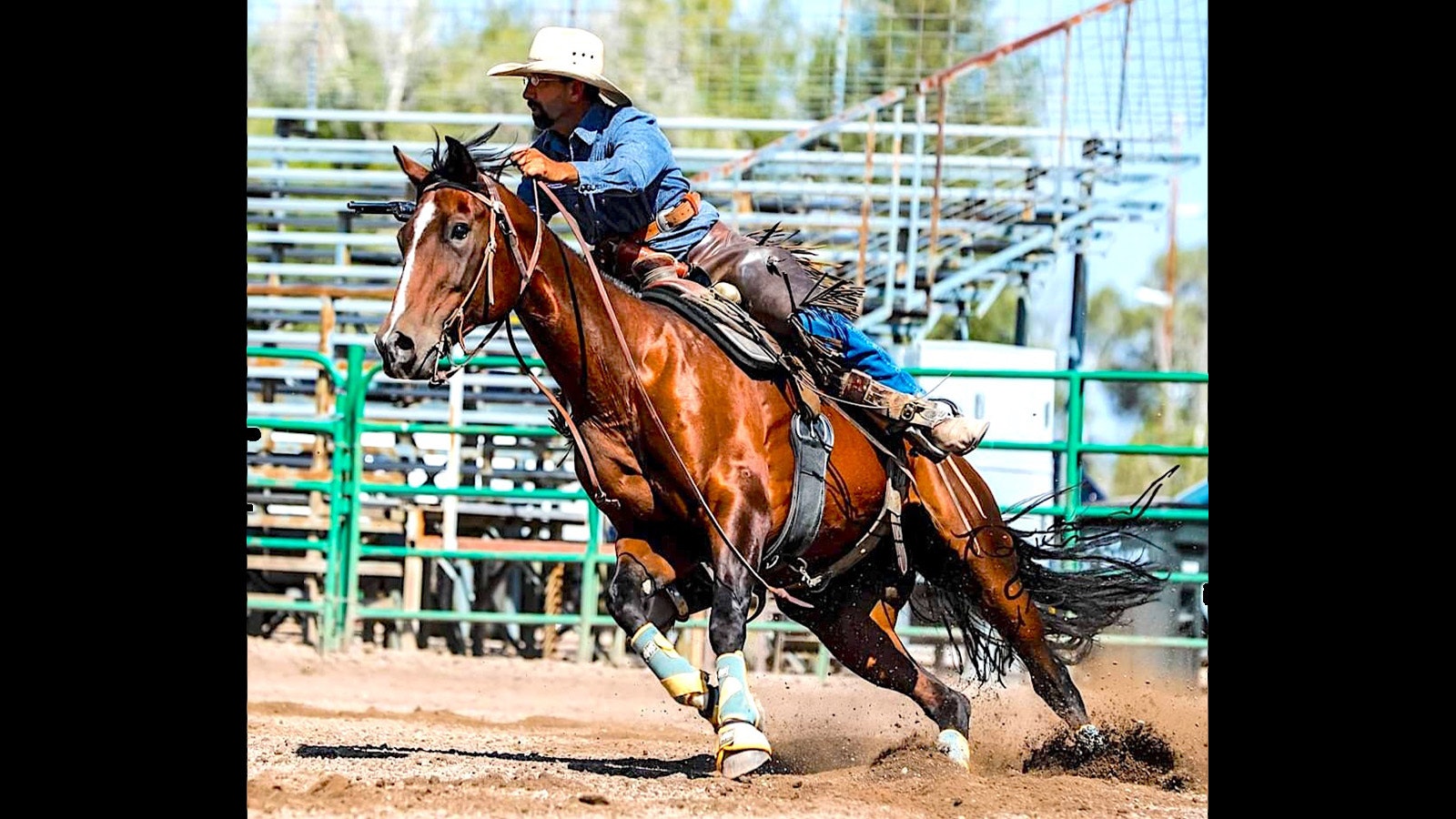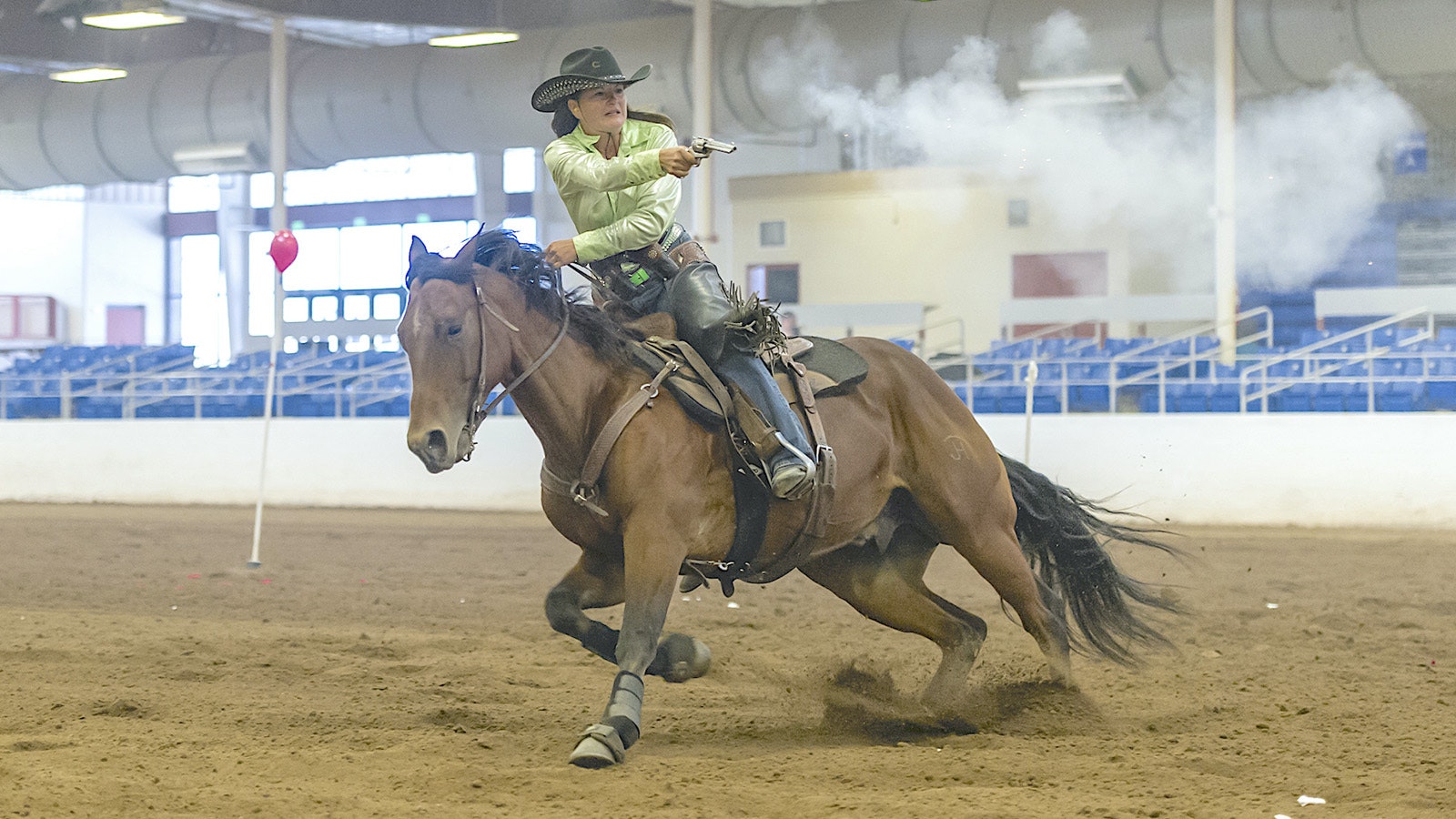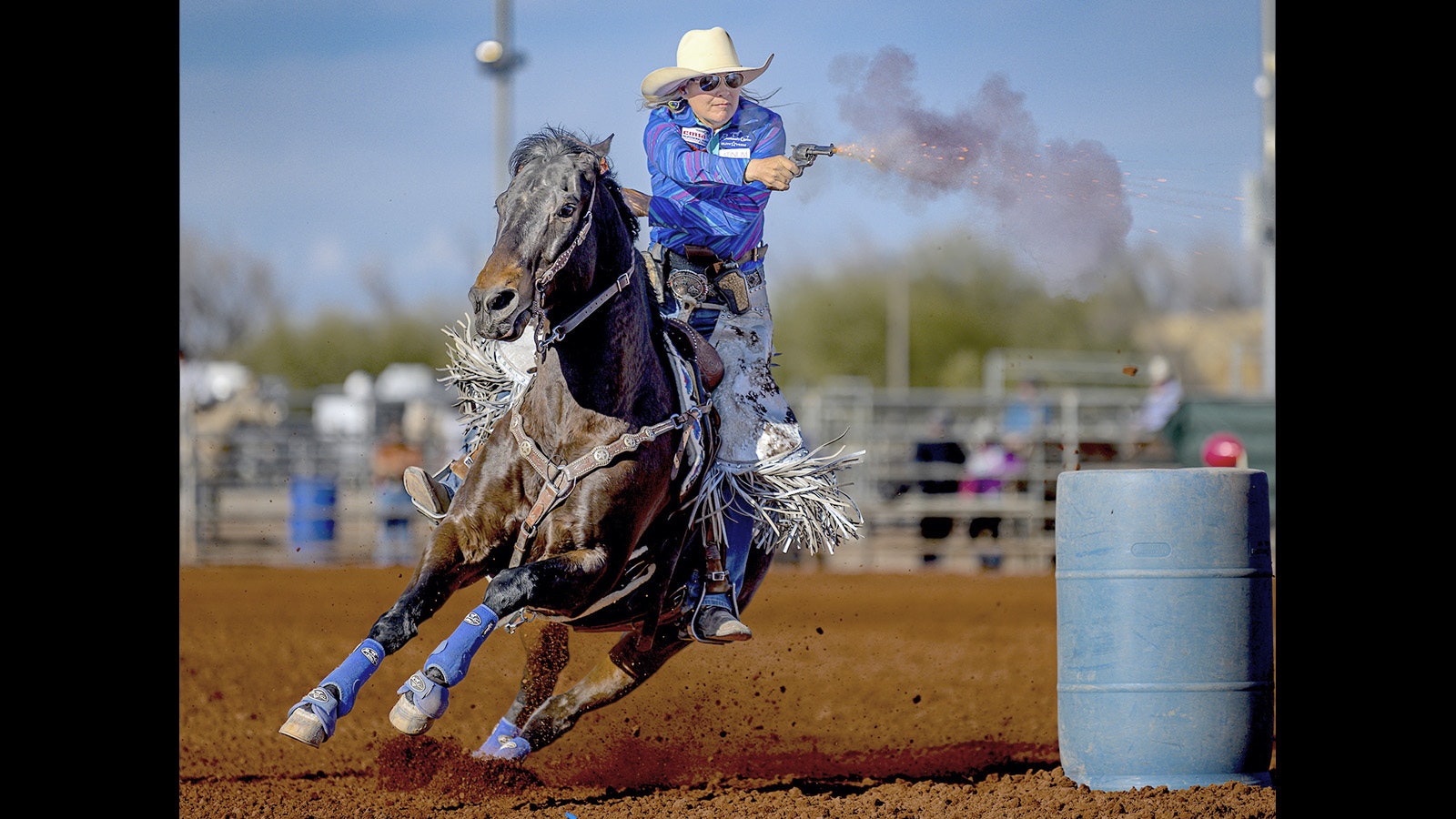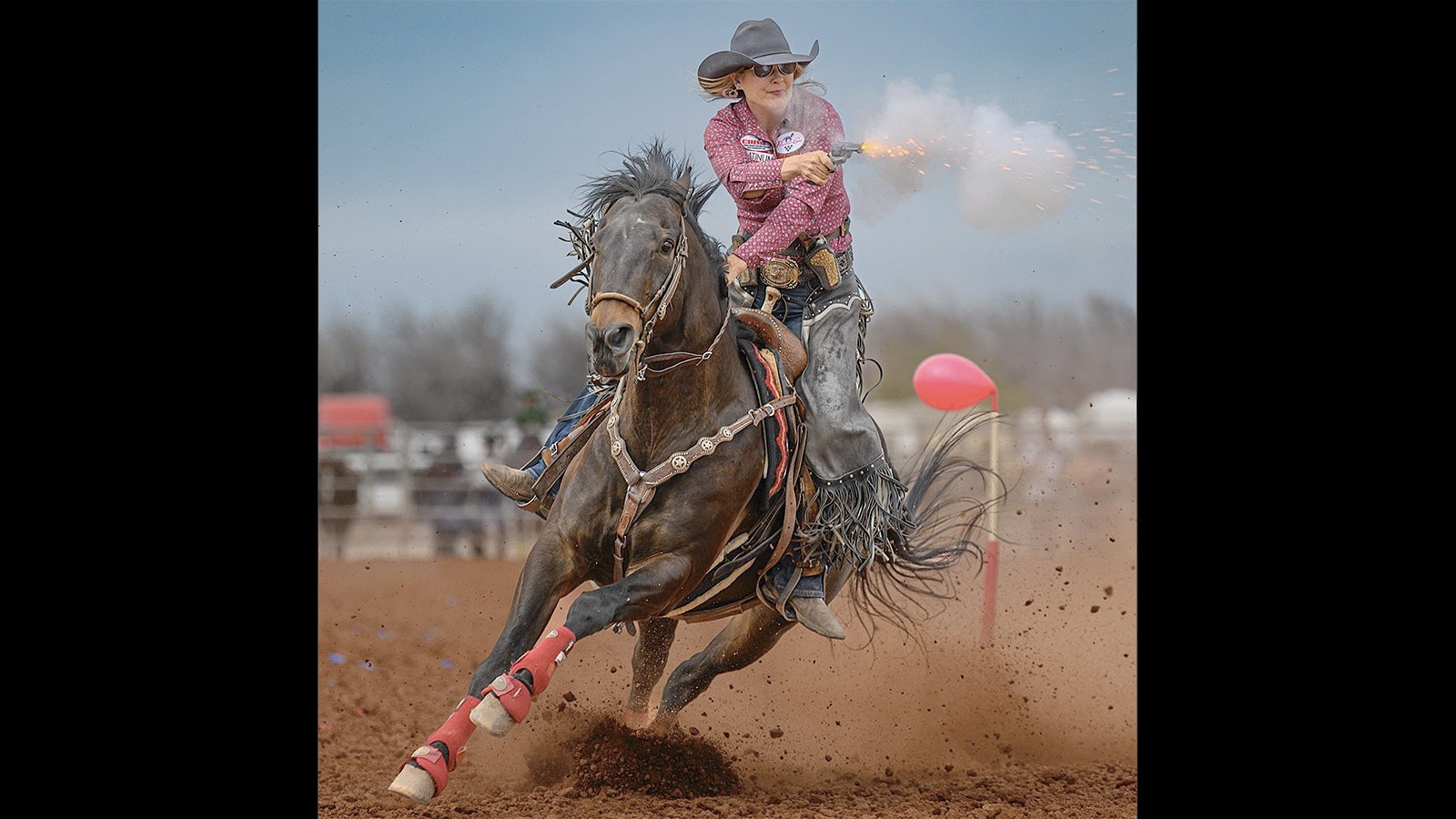Imagine the following job qualifications:
· Must own a bombproof, fast horse.
· Able to shoot accurately at a full gallop.
· Fearless under pressure.
· Handy with the steel — pistol, rifle and shotgun.
· Again, your horse must be fast.
Reads like a want ad circa 1871 posted by the Wild Bunch looking for new recruits.
While that may be, it’s also what members of today’s Cowboy Mounted Shooting Association need to develop and hone all the skills of an Old West outlaw — and then some.
Annie Get Your Gun
Cowboy mounted shooting is an offshoot of cowboy action shooting, which also is known as single-action shooting or cowboy 3-gun.
Cowboy action shooting is a competitive shooting sport tracing its roots to Southern California in the early 1980s. In various forms, it typically involves vintage mid- to late-19th century single-action revolvers, lever-action rifles and side-by-side double-barreled shotguns.
Competitors work their way through a field of targets and are scored based on time and accuracy.
Mounted shooting takes the next obvious step and puts all the Western action on horseback.
It began with Jim Rogers in Arizona in the mid-1990s shooting balloons tied to cacti.
Cowboy mounted shooting is growing quickly growing in popularity again after the pandemic cooled things for a while.
A passionate fanbase, hooked on the nostalgia and Americana feel, has helped fuel participation around the world. Some 100 or so CMSA-affiliated groups are up and running in the U.S. and Canada.
Clubs like the Yellowstone Outlaw Regulators (Montana), Wyoming Roughriders, Tombstone Ghost Riders (Arizona) and the California Peacekeepers regularly host events and compete with groups back East like the Bay State Bandits (Massachusetts), Pine State Pistoleros (Maine), Cowtown Rangers (Kentucky) and the Northern Ohio Outlaws.
There are local, regional and national events every season. In Wyoming, watch for the Robert Parish Memorial in Douglas this weekend, the Mid-Mountain Classic in Rock Springs (June 2-4), the Bill Cody Stampede in Cody (Aug. 12-13) and the Star Valley Shoot in Afton (Aug. 25-26).
Mounted Shooting 101
Mounted shooting is about as Western as it gets.
A fast-paced blend of rodeo and shootout, it’s often referred to as barrel racing with an attitude.
Mounted shooting is a timed event using a set of 10 balloons attached to stands. Competitors are assigned one of some 60 pattern variations 24 hours, or less, before their run.
Each rider uses two .45-caliber single-action revolvers loaded with five rounds of certified black-powder blanks that have an effective range of 10-15 feet. There is no projectile. What pops the balloons is a combination of gas and heat as the gun powder is ignited.
Single-action means shooters must cock the hammer back before each shot. After five shots at the five balloons heading out, the rider holsters the first gun and unholsters a second while on the run, and tries to hit the remaining five balloons on the straightaway rundown back to the finish.
There are time penalties for missing a balloon, dropping a gun, messing up the pattern or falling off your horse.
There also is a rifle class and shotgun class at many events. Sometimes a long gun is combined in the same run as a pistol — handgun on the first 5 balloons, rifle or shotgun on the second 5 balloons.
Mounted shooting has divisions for men, women, seniors and youth, with subcategories within those divisions by skill level from 1 to 6.
A dress code applies similar to most rodeos.
Men and women must wear long-sleeved Western-style shirt, five-pocket jeans, chinks or chaps, topped with Western boots and a cowboy hat. Historical late-1800s style costume wear is encouraged.
Shooting Star Kenda Lenseigne
Inclusivity is what this family friendly sport is all about. The CMSA community is tightknit and welcoming.
At every event, beginner Level 1 shooters rub shoulders with today’s top professionals competing in Level 6. There are shooting and horse training clinics for newcomers. Everyone knows everyone in this game.
And everyone knows Kenda Lenseigne.
This Arizona cowgirl is the Tom Brady of mounted shooting. Equal parts barrel racing angel and dead shot gunslinger, she’s Sherry Cervi-meets-Annie Oakley. Let’s just say if Sam Peckinpah were alive, he would have Lenseigne on speed dial under stuntwoman.
In 2009, Lenseigne became the first woman to win the overall world championship. She beat men, women, seniors — everybody. She did it again last year. She’s still the only woman to hold the overall title. Every year, at every event she’s entered in, she’s the one to beat.
“When this sport started out, anyone with a gun and a horse could go out and shoot balloons and compete, but it’s highly competitive now and it has turned into a career for me,” Lenseigne said. “It’s gotten so competitive now over the past decade or so.
“For instance, one pattern we run called the X used to be fast at 12 seconds. Now we are running it in 10 or even 9 seconds to be in the money.”
At the highest level, a clean run (no time penalties and all balloons popped) is almost a necessity. Unless your horse is really, really fast.
“Back in the day, I was winning because I was faster. I could outrun my misses,” Lenseigne said.
When she turned pro, she got serious about mental preparation and visualizing successful runs beforehand.
Lenseigne still misses now and then, but she is still fast.
“Two weeks ago, I was entered in a national event in Tennessee. In Stage 4 of five I left a target behind. I thought, ‘I just spent two grand getting here and now it’s over. This isn’t 1998, I can't pull it off with a miss,’” she said.
But Lenseigne’s overall runs were so fast she did win, even with the 5-second penalty for a missed balloon.
A Job For Quarter Horses
Lenseigne wasn’t always top dog. She admits to her share of broken bones, scars and a body riddled with enough pins and screws to make airport TSA screeners spring to action. It took her a full eight years after introduction to the sport to make the jump to full-time professional.
Now, she hits dozens of competitions every season, on the road nearly every weekend beginning in December through the end of summer. When she’s not competing, she is running clinics across the country and training horses at her ranch outside Phoenix.
The top riders use a quarter horse almost exclusively. The breed is known for its athleticism, intelligence and calm demeanor.
“They’re quick, agile, with a trainable mind,” Lenseigne said.
Her go-to horse has always been Sparky, a rocket of a mare; short-coupled and a low to the ground at 14 hands. But Sparky has been officially retired because of chronic injuries, so Lenseigne has been working a 6-year-old gelding named Winston into the mix. She also has a pair of promising 5-year-olds.
Star Valley’s Shootist Lisa Grimsley
Another ambassador for the sport is Lisa Grimsley.
She moved from Minnesota to Thayne, Wyoming, nine years ago and, once settled in, hosted the first mounted shooting event in western Wyoming in 2016.
It was an instant hit.
“This sport was big in Minnesota. I was surprised when I got here that no one had ever heard of it,” Grimsley said. “A valley with some 20,000 horses and virtually everybody has familiarity with a gun, if not a gun owner themselves. It’s pretty Western here.”
Once familiarized, the community has been hugely receptive and supportive, Grimsley said. She now heads the Wyoming Desperados. They will team with Utah Mounted Thunder to host this year’s Star Valley Shootout at the Lincoln County Fairgrounds in August.
Grimsley competes at Level 4. She rides a seasoned bay gelding with a papered name of Syngyne McCall.
“I bought him as a 2-year-old reining horse. He is smart and athletic, but he hated mounted shooting at first. It took four years before he became competitive,” she said.
Meanwhile, Grimsley’s backup proved a natural. She picked up Tobias James at a winter auction in Minnesota for “next to nothing.” Grimsley had done a little groundwork with Toby, getting him gun broke before an emergency pressed him into service at one event.
“Syngyne went down (with injury) and I always travel with all my horses in training. So, I called on Toby for the first time,” Grimsley said. “I remember one of his first training sessions when I introduced him to gunfire. He kind of yawned, stretched out and peed. ‘No big deal,’ was his reaction.”
Toby was rock solid and Grimsley turned in a clean run that time out. An overnight success.
“A few horses are just not cut out for this sport, mentally. But a lot is how you introduce it, how you train them,” Grimsley said. “People think, ‘Oh, my horse can’t do that.’ But think about it, this country was settled a-horseback. People did everything from the back of a horse 200 years ago.”
Grimsley said she likes her horses to have good arena manners and a competitive mindset. Above all, she wants her mounts to “love their job.”
Other Wyoming competitors
Another Wyoming shooting club is the Wyoming Rough Riders, a 10-member group out of the Mid-Mountain region established in 1997. It hosts the Robert Parrish Memorial this weekend in Douglas.
President Chris Heyer, a Level 2 shooter, has been involved in the sport for about eight years. He rides a paint mare so sketchy her barn name is Blue Froggy. But it’s made him a better shooter, he said.
“I’ve done a lot of different things on horses, and this is the most fun I’ve ever had on a horse,” he said.
Heyer loves the comradery he sees in the sport, even though everyone is competing for prize money.
“I remember this one time I had a horse come up lame at an event. I was dragging my feet toward the scorer’s table, head down, to tell them I was withdrawing,” Heyer recalled. “This guy I don’t even know asked me why I looked so down. I told him and he said, ‘Don’t pull out, ride my horse.’”
It was a high-rated steed and Heyer never forgot it.
Mark Urlacher is a Level 4 shooter out of Powell. He’s been competing since he got out of reining competition years ago. He rides a 19-year-old quarter horse named Lucy who has taken him to nationals. He’s also breaking in a younger horse named Voodoo.
Urlacher says he will try to hit this weekend’s shoot in Douglas. He’s also planning on nationals in Lincoln, Nebraska, in May, as well as July events in North Dakota and Montana.

Gunning For Glory
Maybe the only hindrance plaguing the shooting sport’s growth is cost as a barrier to entry. A horse or two or five, and everything that entails — truck, trailer, tack — is hard enough on the pocketbook. Then there’s the sticker shock of the shootist’s tools of the trade.
“As addictive as the sport is for those of us already in it, we are struggling as a group to add new members, mostly because of the expense,” Urlacher said. “S set of guns will run you $3,000.”
He uses a Ruger model for his .45. He also rocks a Marlin lever-action rifle and a Stoeger shotgun.
Heyer prefers Taylor’s Short Stroke Runnin’ Irons for their low-profile hammer.
“They fit my hand better and are lighter than the Ruger,” he said.
As shooters get more serious and competitive, off-the-shelf revolvers don’t cut it.
Lenseigne opts for a Colt replica made by Uberti.
“I like the low, wide hammer spur. The short stroke (of the hammer) is 60% of the typical,” she said. “I have also lightened it up in every way with custom gunsmith work and a 3 1/2-inch barrel. It’s all about being able to shoot faster.”
Grimsley said firearm choice is highly personal, as is holster styles. She likes the Ruger Montado with a Birdshead grip and Bisley hammer.
“It’s lighter than the [Ruger] Vaquero and super smooth,” she said.

